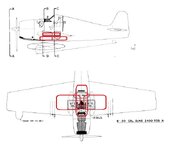Kinda spin-off from the current fast bombers thread.
So Bristol makes an 1-engined fast-ish bomber powered by as single 9 cyl radial engine with 4 x 250 lb bombs (internal stowage), in RAF's service from 1937. 2-3 crew members. Looks like the SBN, or a slightly smaller SBD. Fuel carried is about 170 imp gals for the starters; guns are two .303s udner cowling and one-two trainable.
Next, they make a land-based torpedo bomber - alt Beaufort - with the recess for the torpedo. A bit bigger than the alt-Blenheim (320-330 sq ft wing vs. 280-300 sq ft) or size of the SBD, designed with Taurus engine in mind. The two aircraft can dive bomb well (no worse than the historical Blenheim and Beaufort, later having the highest G load of all British bombers), even if that is not their primary way of attack. Fuel carried is about 250 imp gals, extra fuel can be carried instead of torpedo. In service from 1939. Guns same as on the alt-Blenheim.
Alt-Beaufighter is similar in size to the alt-Beaufort, even uses some parts from it (cue the historical Beaufighter), but Hercules is in the nose, 4 cannons + 4 .303s in the wing (for starters) and additional fuel tank(s) under the cockpit where the recess was for the alt-Beaufort. Defensive .303s in the rear. 300 imp gals in internal tanks as it is introduced. In service from Autumn of 1940.
Alternative engines can also be used, like the R-1830, R-1820, R-2600, Merlin or Griffon, depending on availability and the aircraft type.
How much this scenario improves or hurts the British and Allied war effort? Extra points for over-seas liccene production (as it was the case for historical Bristol A/C), as well as if FAA can get interested in these. Same for introduction of good flaps on these aircraft.
So Bristol makes an 1-engined fast-ish bomber powered by as single 9 cyl radial engine with 4 x 250 lb bombs (internal stowage), in RAF's service from 1937. 2-3 crew members. Looks like the SBN, or a slightly smaller SBD. Fuel carried is about 170 imp gals for the starters; guns are two .303s udner cowling and one-two trainable.
Next, they make a land-based torpedo bomber - alt Beaufort - with the recess for the torpedo. A bit bigger than the alt-Blenheim (320-330 sq ft wing vs. 280-300 sq ft) or size of the SBD, designed with Taurus engine in mind. The two aircraft can dive bomb well (no worse than the historical Blenheim and Beaufort, later having the highest G load of all British bombers), even if that is not their primary way of attack. Fuel carried is about 250 imp gals, extra fuel can be carried instead of torpedo. In service from 1939. Guns same as on the alt-Blenheim.
Alt-Beaufighter is similar in size to the alt-Beaufort, even uses some parts from it (cue the historical Beaufighter), but Hercules is in the nose, 4 cannons + 4 .303s in the wing (for starters) and additional fuel tank(s) under the cockpit where the recess was for the alt-Beaufort. Defensive .303s in the rear. 300 imp gals in internal tanks as it is introduced. In service from Autumn of 1940.
Alternative engines can also be used, like the R-1830, R-1820, R-2600, Merlin or Griffon, depending on availability and the aircraft type.
How much this scenario improves or hurts the British and Allied war effort? Extra points for over-seas liccene production (as it was the case for historical Bristol A/C), as well as if FAA can get interested in these. Same for introduction of good flaps on these aircraft.

